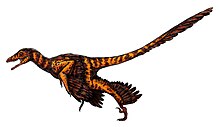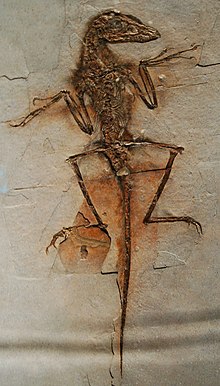Sinornithosaurus
| Sinornithosaurus Temporal range: Early Cretaceous,
| |
|---|---|

| |
| S. millenii fossil displayed in the Hong Kong Science Museum | |
| Scientific classification | |
| Kingdom: | |
| Phylum: | |
| Class: | |
| Superorder: | |
| Order: | |
| Suborder: | |
| Family: | |
| Genus: | Sinornithosaurus |
| Species | |
| |
Sinornithosaurus (derived from a combination of Latin and Greek, meaning 'Chinese bird-lizard') is a genus of feathered dromaeosaurid dinosaur from the Lower Cretaceous Period (late Barremian) of the Yixian Formation in what is now China. [1]It caused a sensation because it was the fifth of the non - avian feathered dinosaur genera discovered by 1999. It was collected from the Sihetun locality of western Liaoning. It was in Layer 6, lower (Chaomidianzi) Yixian Formation, Jehol Group.
Xu Xing described Sinornithosaurus and performed a phylogenetic analysis which demonstrates that it is basal, or primitive, among the dromaeosaurs.[2]he has also demonstrated that features of the skull and shoulder are very similar to Archaeopteryx and other Avialae. Together these two facts demonstrate that the earliest dromaeosaurs were more like birds than the later dromaeosaurs were. This contradicts one argument made by critics of the theory that birds evolved from dinosaurs.[3] See Temporal paradox (paleontology).
Description
Feathers

Both of the Sinornithosaurus specimens above preserved impressions of feathers. They were composed of filaments, and showed two features that indicate they are early feathers. First, several filaments were joined together into "tufts", like the structure of down feather. Second, a row of filaments (barbs) were joined together to a main shaft (rachis), making them similar in structure to normal bird feathers. However, they do not have the secondary branching and tiny little hooks (barbules) that modern feathers have, which allow the feathers of modern birds to form a discrete vane. In NGMC - 91 the feathers covered the entire body, including the head in front of the eye, the neck, wing - like sprays on the arms, long feathers on the thighs, and a lozenge - shaped fan on the tail like that of Archaeopteryx.[4]
Color
A 2010 study indicated that Sinornithosaurus may have had feathers which varied in color between significantly across different regions of the body, based on analysis of microscopic cell structures in preserved fossils.[5]
Classification

Sinornithosaurus was a member of the family Dromaeosauridae, a group of agile, predatory dinosaurs with a distinctive sickle-shaped toe claw, which also includes Deinonychus and Utahraptor. It lived about 125 million years ago in the Barremian age of the Lower Cretaceous period, which makes it among the earliest and most primitive dromaeosaurids yet discovered. The presence of vaned feathers on Sinornithosaurus is consistent with feather evidence from other Dromaeosaurs.
Sinornithosaurus is known from at least two species. S. millenii ("millennium Chinese bird-lizard") is the type species, described in 1999. A second species, S. haoiana ("Hao's Chinese bird-lizard") was described by Liu et al. in 2004 based on a new specimen which differed from S. millenii in features of the skull and hips.[6] An incredibly well-preserved microraptorian nicknamed "Dave" (specimen NGMC 91) may represent a third species of Sinornithosaurus, or a juvenile.
Discovery and specimens

Sinornithosaurus was discovered by Xu Xing, Wang Xiaolin and Wu Xiaochun of the Institute of Vertebrate Paleontology and Paleoanthropology of Beijing. An almost-complete fossil with feather impressions, was recovered from Liaoning Province, China, in the Yixian Formation; the same incredibly rich location where four dinosaurs with feathers were discovered previously, Protarchaeopteryx, Sinosauropteryx, Caudipteryx, and Beipiaosaurus. The holotype specimen is IVPP V12811, in the collection of the Institute of Vertebrate Paleontology and Paleoanthropology in Beijing, China.
Another specimen, NGMC - 91, is probably a juvenile Sinornithosaurus. Qiang et al. (2001) were reluctant to name NGMC - 91 because, although the specimen is completely articulated, almost all of the bones shattered when the fossil slabs were split, so that only the silhouettes of theses bones are clear in most of the part and counterpart. This obscured diagnostic skeletal features, which made the specimen's genus uncertain.[4] NGMC - 91, nicknamed "Dave", is in the collection of the National Geological Museum of China. It was collected in Fanzhangzi quarry, near Lingyuan City, Liaoning Province, China. This is around 130 km from the Sihetun locality. A specimen of the fish Lycoptera is also preserved near the foot of NGMC - 91.
Possible venomous bite
In 2009, a team of scientists lead by Enpu Gong examined a well-preserved Sinornithosaurus skull, and noted several features suggesting it was the first-identified venomous dinosaur. Gong and colleagues noted that the unusually long and fang-like mid-jaw (maxillary) teeth had prominent grooves running down the outer surface, towards the rear of the tooth, a feature seen only in venomous animals. They also interpreted a cavity in the jaw bone just above these teeth as the possible site for the soft-tissue venom gland. [7]
Gong and colleagues suggested that these unique features indicated that Sinornithosaurus may have specialized in hunting small prey such as birds, using its long fangs to penetrate feathers and envenomate and stun the prey, like a modern snake. They also suggested that the short, slightly forward-pointing teeth at the tip of the jaw could have been used to strip feathers from birds.[8]
References
- ^ Swisher, Carl C., Wang, Yuan-qing, Wang, Xiao-lin, Xu, Xing, Wang, Yuan. (1999). "Cretaceous age for the feathered dinosaurs of Liaoning, China". Nature 400:58-61 1 July 1999.
- ^ Xu, Xing, Wang, Xiao-Lin, Wu, Xiao-Chun. (1999) "A dromaeosaurid dinosaur witha filamentous integument from the Yixian Formation of China" "Nature" 401:262-266 16 September 1999.
- ^ Xu, Xing, Wu, Xiao-Chun. (2001). "Cranial morphology of Sinornithosaurus millenii Xu et al. 1999 (Dinosauria:Theropoda:Dromaeosauridae) from the Yixian Formation of Liaoning, China". Canadian Journal of Earth Sciences 38:1739-1752 (2001)
- ^ a b Qiang, Ji, Norell, Mark A., Gao, Ke-Qin, Ji, Shu-An, Ren, Dong. (2001) "The distribution of integumentary structures in a feathered dinosaur" "Nature" 410:1084-1087 26 April 2001.
- ^ Zhang, F., Kearns, S.L., Orr, P.J., Benton, M.J., Zhou, Z., Johnson, D., Xu, X. and Wang, X. (In press). "Fossilized melanosomes and the colour of Cretaceous dinosaurs and birds." Nature, advanced online publication, 27 January 2010.
- ^ Liu, J., Ji, S., Tang, F. & Gao, C. (2004). "A new species of dromaeosaurids from the Yixian Formation of western Liaoning". Geological Bulletin of China. 23 (8): 778–783.
{{cite journal}}: CS1 maint: multiple names: authors list (link) (abstract) - ^ Fountain, Henry (2009-12-28). "Add Venom to Arsenal of Dinosaurs on the Hunt" The New York Times.
- ^ Gong, E., L.D. Martin, D.E. Burnham, and A.R. Falk. (2009). "The birdlike raptor Sinornithosaurus was venomous." Proceedings of the National Academy of Sciences, (not yet published)
See also
External links
- Wang, L. (March 10, 2001). "Dinosaur fossil yields feathery structures". Science News.
- Sinornithosaurus at DinoData
